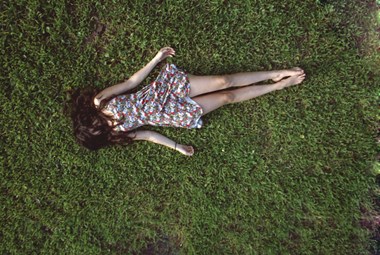The Snake Lady disappoints us. We waited in line for half an hour, weaving through the queues of curious gawkers. Some kids in front of us kick the cage, clang their steel-toed boots against the bars. What we see when we finally reach the cage: a plaster coiled snake body, a woman’s poorly painted head on top. My brother, Kegan, groans, “Fake. So fake. Like they didn’t even try.” I laugh. I am relieved.
We exit, and we spot the next tent with a large banner boasting the World’s Smallest Woman. We dig tickets out of our pockets and pool them to buy entry into the tent. There is no line.
Our ticket taker? I don’t remember. He must have been a bored teenager, some schmuck working for the state fair that week. Or maybe he was an older man, feeling badly about his seasonal job, regretting each patron who entered the tent. I don’t recall.
We walk into the tent—all red and dusty, the air thick with the stench of old frying oil and farm animals. We weave through the attraction and stop to ponder each poster. “This will be fake, too,” Kegan complains. The posters are exaggerated, blown up to be five feet tall or so. We stand in front of a chart that outlines the average woman’s body, arrows pointing to organs. Not to scale, a plaque notes.
The next poster is smaller, red block letters proclaiming, Model to scale. An outline of a miniature body fills the small frame. “The outline reminds me of those police outlines for dead bodies,” Kegan says. He is touching the diagram, poking the woman’s heart. Arrows point to organs on the poster, each caption comparing them to everyday objects. Her heart is the same size as a cherry!
Kegan is a natural skeptic. He is unimpressed.
We round a corner that’s been made with makeshift walls, and we catch sight of a table. A small replica of a house is positioned in the center—like a miniature set design. Small panels are painted to look like a wall with windows and curtains. The windows depict a sunny sky, a lush green apple tree, puffy clouds. A reading lamp is clipped to one of the set walls, its glaring light aimed at the center of the table.
A small rocking chair sits in the middle of the scene. And then we see her: a petite woman—no, too small to call petite. Too unreal to call a woman. She is the size of a doll I had once, like the frontier girl with her accompanying books.
In front of her sits a sign, large letters warning: She does not speak English. Do not speak to her.
My eyes flicker from sign to table to her, looking for more clues about this woman. Her skin is reddish brown like my favorite crayon—a burnt red, a clay brown. Her skin is flawless, glistening under the lights of the tent. Her hair is pulled back and braided, clipped with a bow that must have been made for a doll. Her eyes are so bright. Did I see her blink?
I feel Kegan brush against me—an accidental stagger? The urge to run—I feel it too—but there’s nowhere to go. We are blocked, corralled into this corner by some force—curiosity?
My throat is dry, the taste of sour funnel cake on my tongue. I feel my hand raising, an involuntary reflex, and I see it wave—the casual gesture to an acquaintance across the grocery store.
I see Kegan waving too, an unfamiliar grimace on his face. Is he trying to smile at her? He’s lost his color now. “Hi,” he says—the casual greeting to an old classmate across a parking lot.
We suddenly do not speak English. Our bodies are made of plaster. We are too big for this room. We are too small to be seen. We are unreal. We are not the ones awkwardly waving. We are not two people who paid to see this tiny woman—a spectacle, a specimen. Our hands drop, and we continue to gawk at her. In this moment, we want so badly for her to be real. Did she blink?
She sits, hands folded politely in her lap. Her feet are crossed at the ankles: two black patent leather Mary Janes crossed one over the other. The lace on her socks is perfectly folded into delicate cuffs. Her glassy eyes are fixed on our faces—two tiny marbles glistening under the mock lamplight of her house.
I link my arm with Kegan’s and push him toward the exit. We duck through the exit flap and burst into the sunlight. It feels hotter now, heavier now, and the breeze of cotton candy makes me wretch. I bend over, gripping my knees, feeling my stomach heave.
Nothing comes up.



 The core workshop of SmokeLong Fitness is all in writing, so you can take part from anywhere at anytime. We are excited about creating a supportive, consistent and structured environment for flash writers to work on their craft in a community. We are thrilled and proud to say that our workshop participants have won, placed, or been listed in every major flash competition. Community works.
The core workshop of SmokeLong Fitness is all in writing, so you can take part from anywhere at anytime. We are excited about creating a supportive, consistent and structured environment for flash writers to work on their craft in a community. We are thrilled and proud to say that our workshop participants have won, placed, or been listed in every major flash competition. Community works.